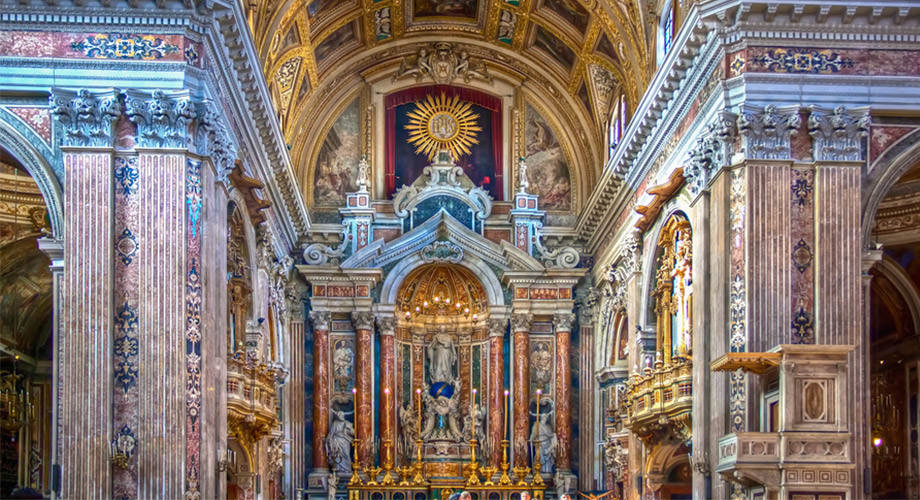
The hundreds of churches in Naples make the city even more unique: here is a tour to discover the most beautiful.
Naples is the city with the greater concentration of churches in Europe and a walk through its streets and alleys can immediately give an idea of the extent of the number of religious buildings present. In fact, according to the official historiography they are about 500, so much that Naples is also called "the city of 500 domes".
For this reason it would be difficult to recommend a tour that allows you to visit them all, but many of the most important are in the historic center for which you can follow a journey to discover basilicas and cathedrals that tell the story of the city and its roots.
Between buildings in style Gothic and Baroque, some of them unique in the world, and structures that merge architectural styles diversi, the tourist will be guided on a very fascinating tour in churches that also hold precious works of art and impressive memorials.
Church of the Gesù Nuovo
a wonderful example of Neapolitan baroque
The tour starts with the monumental Church of the Gesù Nuovo overlooking the homonymous square and whose interiors represent one of the most valuable examples of Neapolitan Baroque. It is one of the largest and most important in Naples and the only case of a Neapolitan private palace later converted into a church.
It was built by the Jesuits and opened to worship in the 1597, but over the centuries has undergone several renovations, moreover guards the tomb of Saint Joseph Moscati and some of his personal items.
The facade is rusticated with diamond-tipped piperno stones, one of the rare cases in Italy, and until recently hidden a mystery, then solved in 2010. In fact, some of these stones show signs that are repeated on a regular basis, incisions believed to be linked to alchemical renaissance mysteries. In reality it is about musical notes that make up a music of about 45 minutes.
The portal is in marble and contrasts with the rest of the façade with its baroque and classical elements, but on the whole it is very original. The interiors, on the other hand, are totally baroque, they leave you breathless for the very bright polychrome marble claddings and the Greek cross plan is divided into three naves and ten chapels. Once inside you can not look up and admire the wonderful dome with stucco decorations and frescoes.
The chapels were decorated by great painters and sculptors, including Fanzago, Bernini, Giordano and Solimena, but the one that most attracts believers and tourists is the chapel with the body of Moscati. Along the right aisle you can also access some rooms dedicated to the Saint in which his clothes and tools of the trade are kept. A particularity of the church concerns the presence of a miraculously unexploded bomb during the Second World War and today exposed to the public.
Timetables:
- 7.00 - 13.00 and 16.00 - 20.00
- Schedules may vary
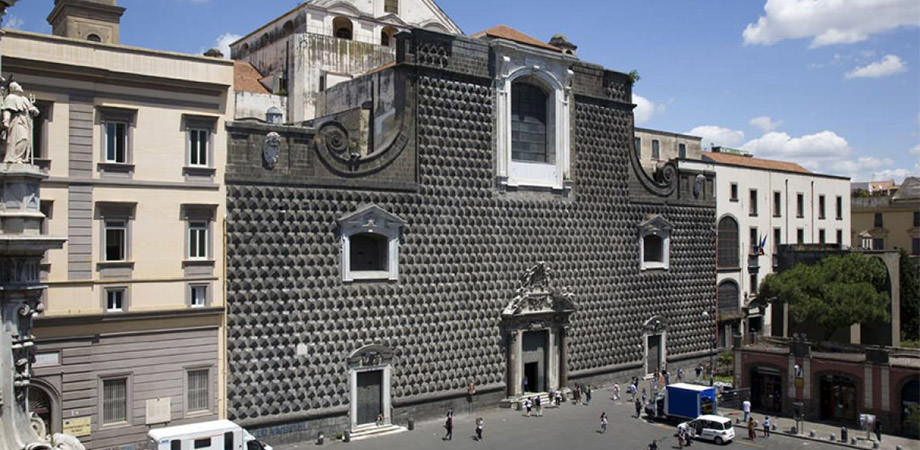
Address: Piazza del Gesù Nuovo, 2 - 80134 Naples 0815578111
Complex of Santa Chiara
the Gothic Basilica, the beautiful Maiolicato Cloister and the ancient baths
On one side of Piazza del Gesù stands the Complex of Santa Chiara. With the Basilica, i four monumental cloisters including that Maiolicato, i Archaeological Excavations and the Opera Museum with part of Giotto's frescoes is another of the must-see stops in the city. Its history has been very eventful and its architecture has also changed over the centuries as the structure has been refurbished numerous.
The church it was commissioned by King Robert of Anjou in the 1310 and was built according to the Provençal Gothic lines, but in the 18 century it was largely restored with Baroque elements and, in the same period, the beautiful marble floor that can still be admired today.
Unfortunately a serious fire following a bombing of the 1943 destroyed almost all the interiors, including almost all the beautiful frescoes made by Giotto. The renovation works lasted about ten years and today the sculptures and the sepulchres still intact are kept in the Museum of the Opera with the remains of the frescoes.
After the post-war works, the basilica resumed its medieval appearance: ha a single long nave with 20 chapels and in the presbytery there is the sepulcher of Robert of Anjou, while in a chapel on the right there are the tombs of some members of the Bourbons.
The Monastery is located behind and what characterizes it is the Clare of the Clarisse cloister. Its wonderful majolica of the 700, the Baroque frescoes, the portico, the arches, the Fountain with the lions and the flowerbeds make it one of the most beautiful architecture of Naples.
Archaeological excavations, on the other hand, are the largest thermal complex found in Naples dating back to the first century AD
On the outside, on the left of the church, stands the Fourteenth-century bell tower with marble elements and between the base and the first level we notice some Angevin inscriptions that tell the story of the church. Currently, work is under way to open access to the public.
Entrance to the church is free, but the complex with the Cloister and the Excavations is subject to charges.
Church Hours:
- 7:30 13:00
- 16:30 20:00
- they can change
Monumental Complex Times
- weekdays 9: 30 - 17: 30
- Sunday 10: 00 - 14: 30
- the last input is always 30 min. before closing.
Prezzi:
- Adults: € 6,00
- Reduced: € 4,50 (students <30 years, teachers, over 65, groups> 25 units)
- Special rate: € 3,50 (Secondary school groups of I and II degree)
- Free: 100% disabled, religious, children <7 years.
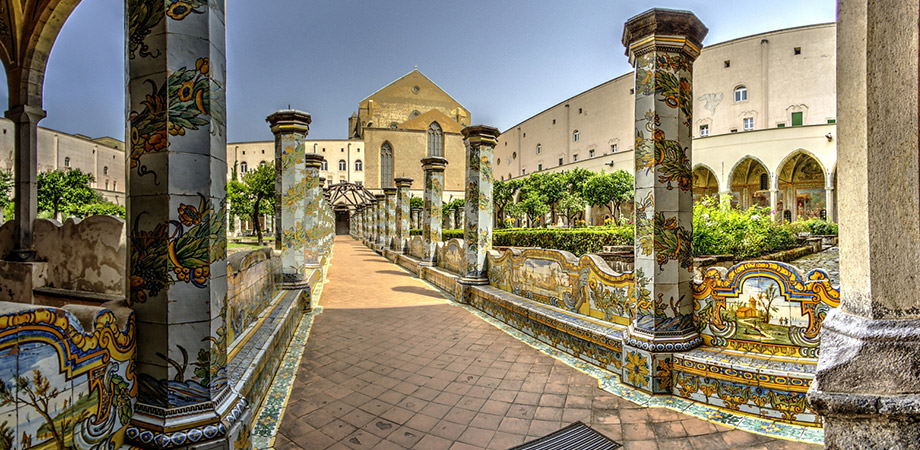
Address: Via Santa Chiara, 49 / C - 80134 Naples 0817971224
Complex of San Domenico Maggiore
the Basilica and the Convent where Saint Thomas Aquinas studied
Continuing on Via Benedetto Croce you arrive in Piazza San Domenico Maggiore with the homonymous religious complex, one of the largest in Naples considered the whole of Basilica and Convent. It was built by Charles of Anjou from the 1283 and deserves a visit not only for its monumental beauty, but also for the prestige that distinguishes it because the philosopher Tommaso d'Aquino studied there and today it is still possible to visit his cell.
The original style of the Basilica is Gothic, but over the centuries the many restorations have profoundly changed it. In fact between the '600 and the' 700 have been made different baroque interventions, in the 800 was the subject of some restoration, while during the Second World War it was damaged by the bombings and the new restorations brought to light the eighteenth-century elements.
The main entrance is located in Vico San Domenico, but also from the Piazza you can access the Basilica via the large staircase. Inside it is wonderfully rich in paintings and sculptures and the gaze is immediately captured by the central nave and the coffered ceiling with gilding, in Baroque style. It is divided into three naves with 27 chapels among which stand out the Cappellone del Crocefisso containing the reproduction of the Crucifix that according to tradition would have spoken to d'Aquino, and the Cappella degli Affreschi, the only one with a cycle of frescoes from the Angevin era. Not to be missed are the Sacristy with the bodies of some Aragonese, and the Treasury Room which exhibits sacred objects and vestments of the highest historical and artistic value.
The convent, on the other hand, is divided into three floors and is located in the first one cell of St. Thomas Aquinas with the original painting of the Crucifixion. On the first floor there are also the Sala del Capitolo with valuable stuccoes.
Timetables:
- Monday to Saturday from 9,00 to 19,00 (last entry 18,30 hours)
- schedules may vary
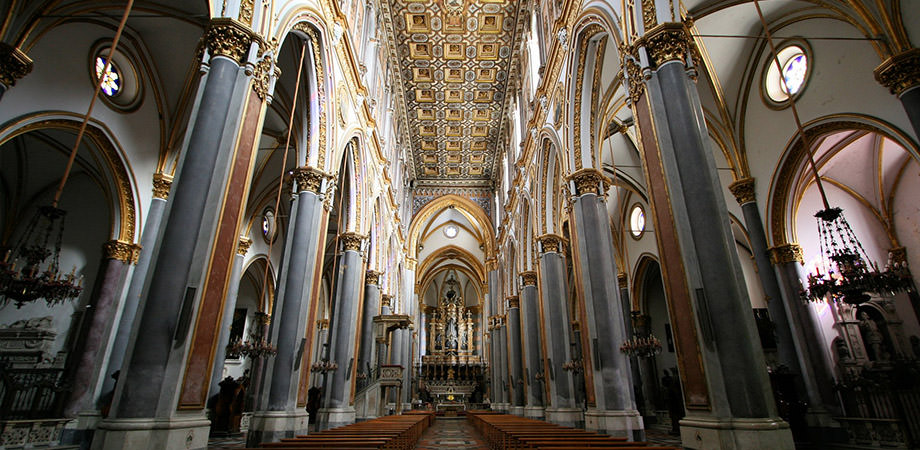
Address: Piazza S. Domenico Maggiore, 8 - 80134 Naples 0810083901
Church of Sant'Aniello a Caponapoli
the highest point of ancient Greek Neapolis
From Piazza San Domenico Maggiore we continue the tour going up to Vico San Domenico Maggiore and, coming out on Via dei Tribunali, we continue to climb on Via del Sole, which is adjacent to Piazzetta Miraglia. We will get to the Church of Sant'Aniello a Caponapoli or Church of Sant'Agnello Maggiore or Santa Maria Intercede. It is very important because there are preserved remains of the ancient walls of Neapolis and is called "a Caponapoli" because it stood at the highest point of the ancient city. The Greeks used this area to better defend themselves from attacks from the sea and settled there.
Sant'Agnello is a patron of Naples and according to tradition is buried in this church, even if it is not certain news because his body could be in Lucca. He was bishop of Naples in the fourth century AD and it seems that his parents had a small church built to thank the Virgin of the birth of an heir, naming her own Santa Maria Intercede. Over the centuries it was enlarged and rebuilt until it was completely rebuilt in the sixteenth century with some interventions in the following two centuries. In '900 was hit by earthquakes and wars, so it was objects of new restorations and, after a long period of closure, it was reopened after important work in the 2011.
Inside the church, as mentioned, there are important remains from the Greek era that are kept under the floor and are visible through a glass protection. But there are also evidence of medieval era, beautiful decorations and bas-reliefs, as well as the high altar of the sixteenth century sculpted by Girolamo Santacroce. On the walls you can admire paintings by the major artists who stayed in Naples, including Caracciolo, Stanzione, De Mura and Solimena who painted the "Magdalene" on the main altar.
Timetables:
- Monday from 17: 00 to 19: 00
- Wednesday from 17: 00 to 19: 00
- Thursday from 9: 00 to 12: 30
- Friday from 9: 00 to 12: 30 and from 17: 00 to 19: 00
- Sunday from 10: 00 at 12: 30 (only the second and fourth of the month)
- Schedules may vary
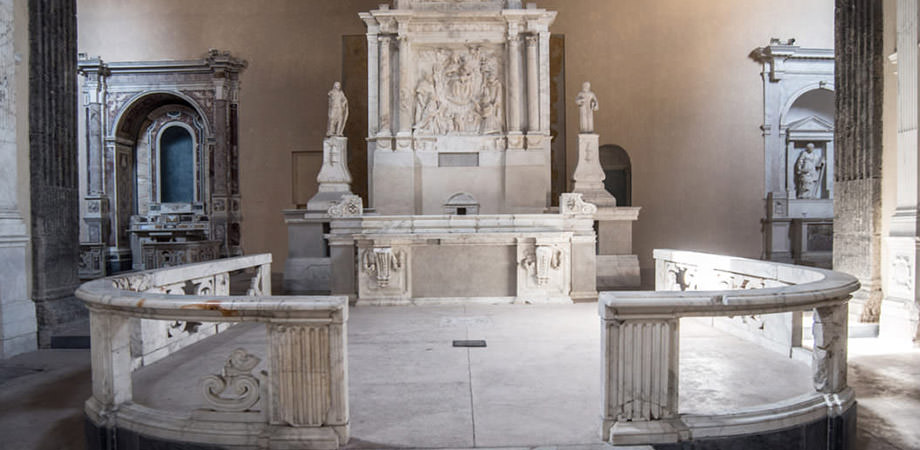
Address: Vico S. Aniello in Caponapoli, 9 - 80138 Naples 0810335712
San Paolo Maggiore
on the remains of the Roman Temple of the Dioscuri
Going down Via del Sole you find yourself on Via dei Tribunali and, continuing, on the left you come across another important church in Naples, in Piazza San Gaetano. There San Paolo Maggiore was a temple previously and you can immediately notice it by the presence of two tall Corinthian columns on the main facade with its architraves. Indeed, it was built on the remains of the Temple of the Dioscuri, a Roman temple probably built concurrently with the foundation of the city. On the façade there are also the two statues of Peter and Paul.
The first church dedicated to St. Paul was built between the eighth and ninth centuries, but during the 500 there was a great reconstruction with important embellishment works in the 600 and 700. Also this church was seriously damaged by the bombs in the 1943 and during the renovations emerged remains of the temple and a cemetery. Inside the church has three naves and on the ceiling, still damaged by the war, you can admire the beautiful frescoes by Stazione with Pietro and Paolo and the victory of the Neapolitans on the Saracens. On the left side of the central nave is the statue of the Guardian Angel by Domenico Antonio Vaccaro, while the side aisles contain 8 chapels with stuccoes and frescoes and in the left aisle stands the funeral monument with the bust of the mathematician Nicola Fergola. Also in the transept there are valuable chapels including one dedicated to Saints Peter and Paul with important reliquaries.
Finally, in the convent of the church there are two cloisters: the small presents columns that belonged to the early Christian church, while the large cloister now houses the Notary Archive of Naples.
Timetables:
- From Monday to Saturday from 09: 00 to 17: 30
- Sunday from 09: 30 to 13: 30
- Schedules may vary
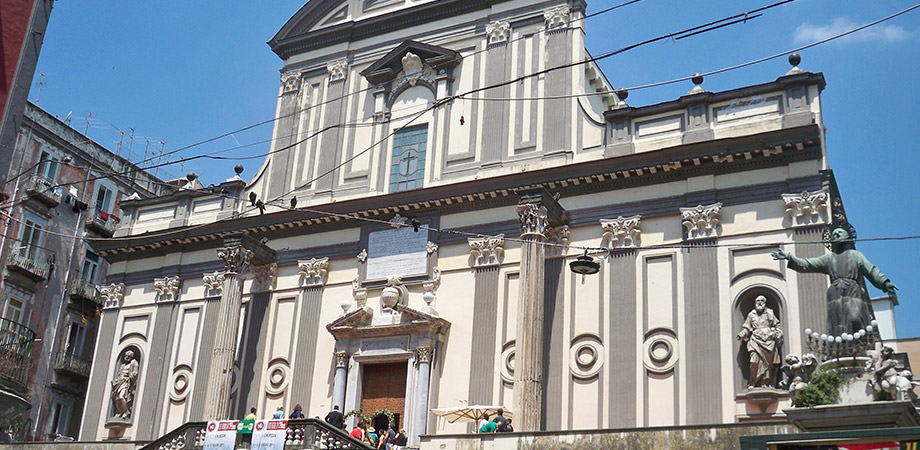
Address: Piazza San Gaetano, 76 - 80138 Naples 081454048
Basilica of San Lorenzo Maggiore
a journey through time in the buried Neapolis
Leaving the Basilica of San Paolo Maggiore you will be in front of the Basilica of San Lorenzo Maggiore, always wanted by Charles of Anjou, and also home to the Opera Museum which includes the Archaeological excavations of the buried Neapolis. It too is a fine example of the presence of different architectural genres ranging from French Gothic, of which the example isunique apse in Italy, in seventeenth-century baroque whose elements can be seen on the Sanfelice façade.
The history of the Basilica has been rich in important events, among which stand out the meeting between Boccaccio and the beloved Fiammetta, the stay of Petrarch in the 1343 and the assault on the tower used as an artillery outpost by Masaniello against the Spaniards.
The marble portal is Gothic and there are still the wooden doors of the '300 and on the right side of the baroque façade there are the convent and the bell tower of the' 400. On the facade you can admire the crests of the seats of Naples, which represented a sort of parliaments of the various districts of the city.
Inside there is a single nave with 16 side chapels where the gothic style dominates with white and pink marble elements that are owned by important families. In the area of the transept there are valuable frescoes of the '300, while the apse as said is unique in Italy. In fact, it is in French Gothic with very high pillars on which there are arches behind which there is a corridor (ambulatory) with nine chapels.
A separate mention deserve them archaeological excavations under the convent which, thanks to their stratification, allow us to know a part of the Greco-Roman history of the city. In fact, they have structures dating from the fourth century BC to the first century AD and have brought to light the ancient macellum, that is the market with the commercial shops.
The entrance to the church is free, you pay the entrance to the excavations.
Timetables:
- 9: 30 - 17: 30 (every day)
- Schedules may vary
Excavation Prices:
- 9 € - Full ticket
- 7 € - Artecard, University Professors and Over 65
- 6 € - Under 18
- € 4 - School groups
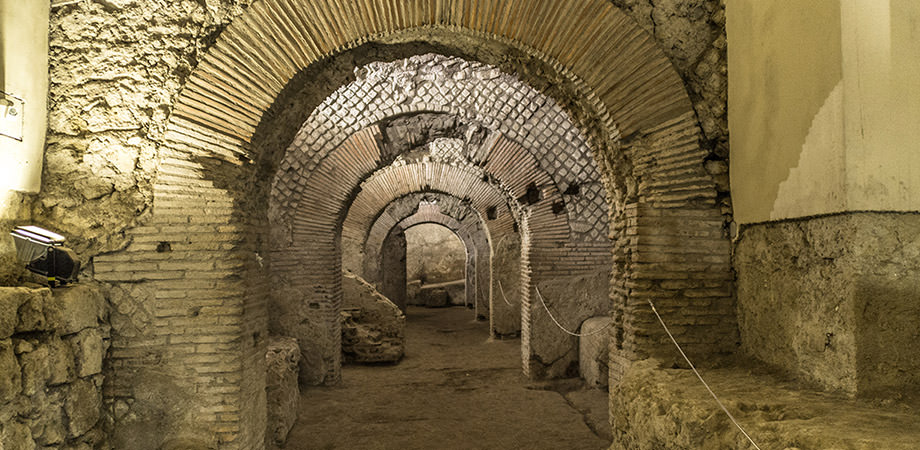
Address: Piazza San Gaetano, 316 - 80138 Naples 0812110860
The Cathedral of Naples
a thousand-year history on the ruins of the former Temple of Apollo
We continue the tour arriving at Duomo, which is located on the homonymous street that crosses Via dei Tribunali. It is the cathedral of the city, one Monumental Basilica that incorporates two other churches that arose separately from it. This is the Basilica of Santa Restituta, which in turn has arisen on the ruins of the Temple of Apollo which contains the the oldest early Christian baptistery in the West, and the Chapel of the Treasure of San Gennaro which houses the relics and blood of the patron.
The famous takes place three times a year miracle of the dissolution of the blood of San Gennaro, but its importance is also artistic because the structure is the layering of different styles ranging from the Gothic of the '300 to the neo-Gothic of the 800. What you notice immediately is his 50 meters high Gothic facade with three portals that over the centuries has undergone various changes. The original fourteenth century is now lost and has been rebuilt several times, definitely only at the end of 800.
The interior is divided into three naves and it is important to note in the presence of ancient Roman columns which incorporate the stems on which the arches rest. The beautiful coffered ceiling of the central nave is carved and gilded and all the walls are there dozens of paintings, including those by Luca Giordano. On the counter-façade there are the sepulchres of Charles of Anjou I and Carlo Martello d'Angiò, while the side chapels are dedicated to important Neapolitan families. From a door in the left aisle you access the Basilica of Santa Restituta with the baptistery of San Giovanni in Fonte enriched with turquoise blue and green mosaics with parts in gold. Here there are also archaeological excavations with rare remains of the Greek era belonging to the Temple of Apollo, a section of a Roman aqueduct and parts of early Christian floors.
In the Cathedral there is the Royal Chapel of the Treasury with masterful examples of Baroque Emilian painting and keeps the ampoules with the blood of San Gennaro.
Admission to the Cathedral is free, while access to the Baptistery is subject to charges.
Duomo times
- Monday to Saturday: 8.30 - 12.30 / 16.30 - 19 | Sunday: 8.00 - 13.30 / 17.00 - 19.30
- Excavations: from Monday to Saturday. 8.00-12.30 / 16.30-19.00 | Sunday 8.00-13-30 / 17.00-19.30
- Schedules may vary
Hours of the archaeological area
- weekdays 9 -12 / 16.30 - 19
- holidays and days before public holidays 9 - 12.30
- Schedules may vary
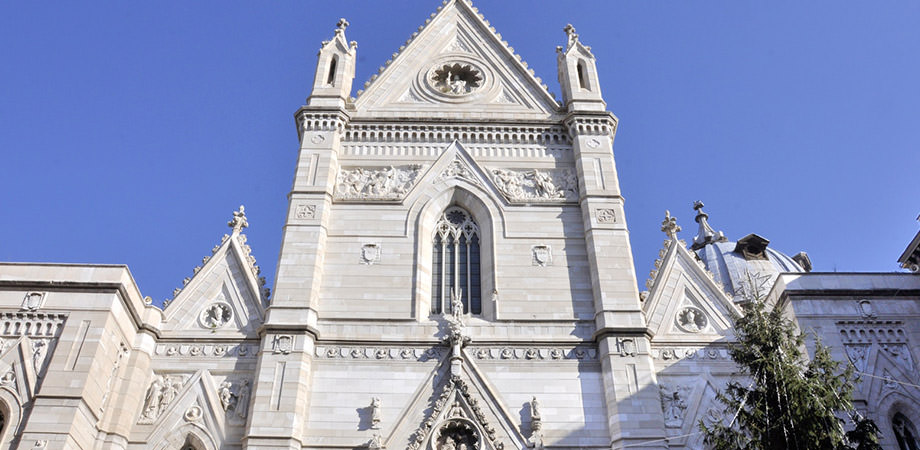
Address: Via Duomo, 147 - 80138 Naples 081449097
Churches of Old Donnaregina and New Donnaregina
a single complex with priceless frescoes
La Church of Santa Maria Donnaregina Vecchia it is not far from the Duomo and, together with New Donnaregina, Is part of the Diocesan Museum in Naples.
Old Donnaregina preserves one of the largest and most important cycles of frescoes from the 14th century of Naples and is a truly ancient structure because already from the 780 it occupied an area of the Greco-Roman city. The Queen Giovanna II d'Angiò, at the end of the 1300, commissioned major renovations and the enlargement with the church of Donnaregina Nuova took place in the seventeenth century. The two churches were hoped for in the 1928-1934 period to ensure that the gothic structures of the apse hidden from the new structure were brought back into view.
Old Donnaregina welcomes the visitor with the eighteenth-century cloister "dei Marmi" which leads to the only aisle that arrives at the apse with the choir of the nuns spread over the lowered ceiling. This area presents a majolica tiled floor an expression of the Angevin ceramics and frescoes of both the Angevins and the House of Hungary, of which Queen Maria is a part who wanted the construction of the convent. The sovereign is honored by the magnificent sepulchral monument realized by Tino di Camaino. The element that makes the visit unique is the cycle of fourteenth-century frescoes which is in a hall on the right side and which is of unknown attribution.
All projects Church of Donnaregina Nuovainstead, it is accessed via one marble and piperno staircase and the interior has a single nave with 6 chapels with baroque marbles. The vault is a typical example of Barocco Neapolitan and contains large cycles of seventeenth-century frescoes. There are two major works of art great paintings by Luca Giordano on the sides of the altar, on the "Marriage of Cana" and the "Multiplication of loaves and fish", but also the paintings of the Neapolitan school that are found in the sacristy and in the comunichino. Finally, the two fantastic choirs, which are accessed via stairs, conserve frescoes by Solimena and Luca Giordano.
Old and New Donnaregina timetables
- Monday, Wednesday, Thursday, Friday, Saturday: 9.30 - 16.30
- Sunday: 9.30 - 14.00
- Closed on Tuesday
- Schedules may vary
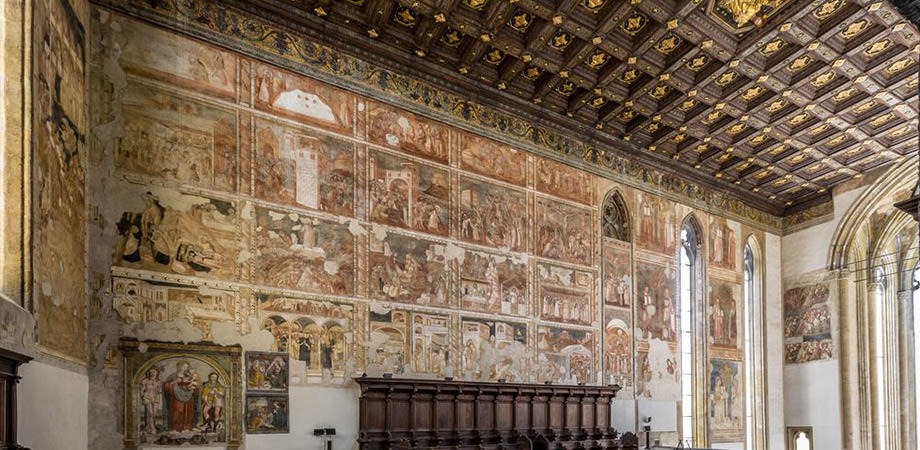
Address: Largo Donnaregina, 1 - 80138 Naples 0815571365
Church of San Giovanni a Carbonara
with the largest funeral monument of the south
Returning to via Duomo and taking via Settembrini up to via Carbonara you reach the church of San Giovanni a Carbonara, one of the most important Renaissance structures in Naples thanks to the impressive sixteenth-century sculptures and paintings of the same period. Its construction dates back to the 1339, but the most important expansion is due to King Ladislaus, to which the great funeral monument and the adjacent park. It was also an important cultural meeting place in the Renaissance and men like Pontano and Sannazaro confronted each other. Thanks to the intervention of the Caracciolo family who embellished it with apse chapels, the monumental cloister, while i damage from the Second World Wars eliminated some nineteenth-century additions.
It is accessed via the monumental staircase in piperno of Sanfelice and from the facade you can see how the church is the overlapping of multiple structures: S. Giovanni, the sixteenth century Seripando chapel and the Consolazione church in Carbonara, all structures with separate entrances. Once inside it is immediately captured by the huge funeral monument dedicated to King Laidslaoin Gothic style and one of the largest of the '400 in the south. It dominates the environment and represents, in the 4 levels, the lying King, the Horse King and Ladislao and his sister Giovanna enthroned. Other noteworthy elements are the Caracciolo del Sole Chapel with the renaissance-style family tombs with the beautiful majolica floor and the Caracciolo di Vico chapel, one of the earliest examples of the Roman Renaissance.
Behind the Church, finally, there are convento and the cloisters of Ladislao, Porteria and Nuovo, which today have different uses from those conventual.
Timetables:
- Monday 8-12, 16.30-20.30
- Tuesday 8-12, 16.30-20.30
- Wednesday 8-12, 16.30-20.30
- Thursday 8-12, 16.30-20.30
- Friday 8-12, 16.30-20.30
- Saturday 8-12, 16.30-20.30
- Sunday 8-14
- schedules may vary
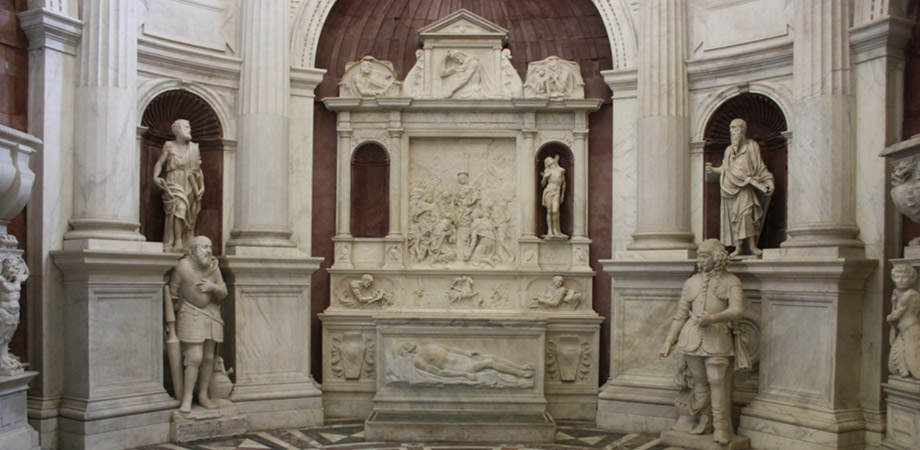
Address: via Emanuele de Feo, 60 - 80134 Naples
Church of Sant'Eligio Maggiore
the elegance of the oldest Angevin church in Naples
Continuing on via Carbonara and arriving on via Pietro Colletta you reach the Church of Sant'Eligio Maggiore, not far from Piazza Mercato. What distinguishes it at the first impact is the large arch with the clock built in the fifteenth century that connects it to a nearby building. It was built in 1270 and is the oldest of the Angevin period in the city.
During the 16th century, theEducated Female to educate the girls for nursing service and, during the same period, the first renovations were made. Various works were repeated until the first half of the 800 and they modified the Gothic architecture. After the damage of a heavy bombardment of the 1943 there was one restoration that brought to light the original Gothic lines.
A legend is linked to the bow with a clock on the two figures inserted under its frame: Irene Malabri and Antonio Caracciolo. It is said that the nobleman, in love with the woman who did not reciprocate him, he unjustly condemned his father asking, in exchange for his release, the girl's hand. To obtain justice, the family of Irene church to King Ferdinand II of Aragon to condemn the Caracciolo to death, after having had it forced to marry with the girl to provide her with the dowry.
The entrance is no longer in the main portal, but in the lateral one in the French Gothic style. The interior is in yellow tuff and layers of gray piperno, is divided into three naves with side chapels and full of works of art including a painting by Cornelis Smet which is a copy of the Last Judgment by Michelangelo. In the Sala Sant'Eligio, once used by the sovereigns for popular feasts, there are frescoes and paintings with the Stories of the Liberated Jerusalem. Two cloisters also belong to the church, one of which with a 17th century piperno fountain.
Timetables:
- Monday to Saturday 8: 30-13: 00
- Sunday 9: 00-13: 30
- times may vary
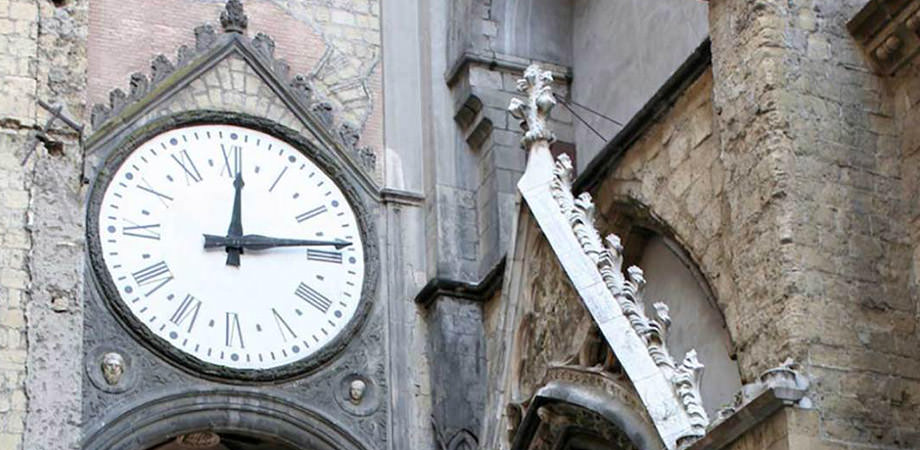
Address: Via San't Eligio, 4 - 80133 Naples 0815538429
Basilica of Santa Maria del Carmine Maggiore
devotion, miracles and traditions
La Basilica Sanctuary of Santa Maria del Carmine Maggiore it can be reached by going on via Marina and continuing for a few minutes to Piazza del Carmine. Erected in the XIII century, it is one of the largest in Naples and a unique example of the Neapolitan Baroque.
The Church of the Carmine is to be visited for numerous reasons, one of which is theicon of the famous Madonna Bruna, named for the dark color of his skin. It is said that it was brought from Palestine by some monks who fled from the Saracen persecutions, although in reality it seems to be the work of an author of a Tuscan school of the thirteenth century. In the Church there is also the funeral monument of Corradino di Svevia, with his mortal remains, heir of the House of the Hohenstaufen, defeated and beheaded by Charles of Anjou.
Another element that characterizes the church is the so-called Miraculous Crucifix that the 26 December of each year, for 8 days, is unveiled to the public. According to tradition, during the battle between the Angevins and Aragonese in the 1439, an Aragonese cannonball broke through the church in the direction of the crucifix who lowered his head to avoid the blow and, subsequently in sign of forgiveness for the gesture, King Alfonso built a tabernacle inaugurated just the 26 December 1459. Finally, inside there are various gravestones that recall the places of the church in which Masaniello was first killed and then buried.
The current facade is of the 1766, while the bell tower repeatedly damaged it has assumed the aspect that we see today in the first half of the seventeenth century. IS the highest in Naples with its 75 meters and every year, the 15 July, is "ignited" with fireworks in honor of the Blessed Virgin Mary of Mount Carmel.
The interior, originally in Gothic style, was completely replaced by the Neapolitan Baroque in the second half of the '700 and is rich in polychrome marble with a wide nave and a beautiful coffered ceiling. There are numerous in the 12 chapels paintings, altars and paintings, while on the entrance door there is the monumental organ with 4800 canes.
Hours of the sanctuary
- Morning: 6.30 hours
- Afternoon: 16.30 hours
- Schedules may vary.
Closing of the sanctuary
- Weekdays: 12.30 hours
- Wednesday, Sunday and holidays: after the last celebration
- Schedules may vary
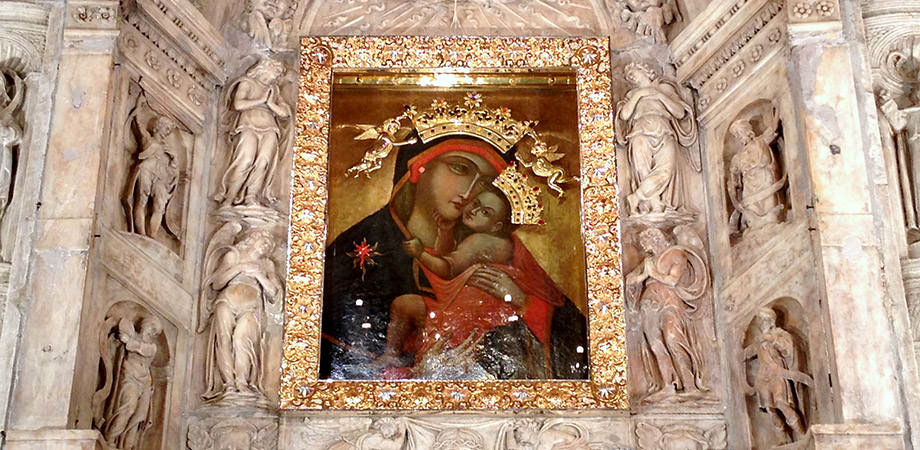
Address: Piazza del Carmine, 2 - 80142 Naples 081201196 - 081200605 - 081201942


